Stephanie A. Mann's Blog, page 19
August 24, 2023
Preview: Blessed Thomas Holford, Convert and Martyr
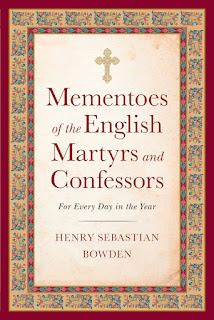 August 28, 1588 was busy day for executioners throughout London, as several new gibbets had been constructed. With the defeat or failure of the Spanish Armada, government officials sought to make quite an example.
August 28, 1588 was busy day for executioners throughout London, as several new gibbets had been constructed. With the defeat or failure of the Spanish Armada, government officials sought to make quite an example. The martyr whose mementoes we'll feature on Monday, August 28, was one of the martyrs who suffered that day, although Father Henry Sebastian Bowden highlights several successful escapes before his final capture, imprisonment, trial, and execution.
So on Monday, August 28, I'll be on the Son Rise Morning Show at my usual time: about 6:50 a.m. Central/7:50 a.m. Eastern: please listen live here and/or listen to the podcast later here.
With the title "A Hunted Life" and verses from the Letter to the Hebrews, "They wandered about in sheepskins and goatskins, being in want, distressed, afflicted: of whom the world was not worthy" (11:37-38), Father Bowden recounts Blessed Thomas Holford, who would be beatified in 1929, and his wanderings:
THE son of a Protestant minister in Cheshire, he was reconciled by Father Davis, and ordained, and his life as a priest seems to have been a fulfilment of the Gospel precept of flight under persecution. " He was first searched for," says Father Davis, "in the house where I lay, on All Souls' Day, but escaped. Again, after being nearly taken in the search for Babington, he repaired again to a house where I was staying, but we escaped to a hay-barn, through a secret place at the foot of the stairs. He then laboured for souls in his own county, Cheshire, was apprehended, sent to London, and lodged in an inn at Holborn. Then, rising early, he managed to pass the pursuivants, who had drunk hard and were asleep. On Holborn Viaduct he met a Catholic gentleman, who, seeing him half-dressed, thought him a madman. Pulling off his yellow stocking and white boot-hose, he walked barefoot by unfrequented paths till he arrived, late at night, at a house where I lay, about eight miles from London. He had eaten nothing, and his feet were bleeding and torn with briars and thorns. My hosts and their daughters tended him and put him to bed. The next year he was apprehended, and executed, August 28, at Clerkenwell." (p. 265, entry for August 17)
In his Memoirs of Missionary Priests and other Catholicks of both Sexes who suffered Death or Imprisonment in England on account of their Religion, from the year 1577 till the end of the reign of Charles II, Bishop Richard Challoner (from whom Father Bowden excerpted this memento) adds this detail about Blessed Thomas Holford's final capture:
After this escape, he avoided London for a time, but the next year, 1588, he came to London to buy him a suit of apparel. At which time, going to Mr. Swithin Well's house, near St. Andrew's church in Holborn, to serve God (i. e. to say Mass) Hodgkins the pursuivant espying him as he came forth, dogged him into his tailor's house, and there apprehended him.
Just a little context: After his conversion, Holford left England to study for the priesthood in Reims, arriving there on August 18, 1582; he was ordained in Laon on April 9, 1583, and returned to England on May 4 that same year.Fathers Davis and Holford were having to move around so much because of the discovery of the Babington Plot against Queen Elizabeth I, to replace her with the imprisoned Mary, Queen of Scots.Saint Swithun Wells is one of the 40 Martyrs of England and Wales, executed on December 10, 1591 after another Mass was celebrated in his home on All Saints Day, a Mass he did not attend!Hebrews 11 is the chapter in which the faith of the Old Testament patriarchs is lauded from Abel to Moses and beyond! The full citation of verses 37 and 38 is:
They were stoned, they were cut asunder, they were tempted, they were put to death by the sword, they wandered about in sheepskins, in goatskins, being in want, distressed, afflicted:The full list of those executed on August 28, 1588:
Of whom the world was not worthy; wandering in deserts, in mountains, and in dens, and in caves of the earth.
Blessed Hugh More or Moor, educated at Oxford
Blessed James Claxton
Blessed Robert Morton
Blessed Thomas Felton, whose father, John Felton was executed for posting the Papal Bull excommunicating Elizabeth I after the Northern Rebellion
Blessed Thomas Holford, formerly a Protestant schoolmaster
Blessed William Dean, a former Protestant minister, he had been arrested and exiled and returned to England
Blessed William Gunter or Guntei, from Wales
Blessed Henry Webley, a layman who had assisted Father William Dean
Blessed Thomas Holford, pray for us!
August 17, 2023
Preview: Blessed Thomas Percy's Mementoes
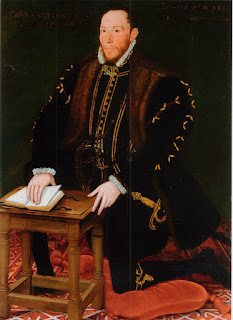 After an hiatus on Monday the 14th as the Son Rise Morning Show prepared for the Solemnity of the Assumption on August 15th, we're back with our series of highlights from Father Henry Sebastian Bowden's Mementoes of the English Martyrs and Confessors, remembering Blessed Thomas Percy, an early Elizabethan martyr.
After an hiatus on Monday the 14th as the Son Rise Morning Show prepared for the Solemnity of the Assumption on August 15th, we're back with our series of highlights from Father Henry Sebastian Bowden's Mementoes of the English Martyrs and Confessors, remembering Blessed Thomas Percy, an early Elizabethan martyr.So on Monday, August 21, I'll be on the Son Rise Morning Show at my usual time: about 6:50 a.m. Central/7:50 a.m. Eastern: please listen live here and/or listen to the podcast later here.
[This Thomas Percy is not to be confused with the Sir Thomas Percy, his father, who participated in the Pilgrimage of Grace during the reign of King Henry VIII, who has not been beatified by the Church. Note from the Catholic Encyclopedia: "When Thomas was eight years old his father was executed at Tyburn (2 June, 1537) for having taken a leading part in the Pilgrimage of Grace, and he also is considered a martyr by many."*]
Father Bowden focuses on the time when Blessed Thomas Percy was imprisoned in Scotland under the title "Friday Abstinence" with verses from the Second Book of Maccabees (6:18-19):
Eleazar one of the chief of the scribes . . . was pressed to open his mouth to eat swine's flesh. But he, choosing rather a most glorious death than a hateful life, went forward voluntarily to the torment.
Some background from the Catholic Encyclopedia:
On Elizabeth's accession the earl, whose steadfast loyalty to the Catholic Church was known, was kept in the North while the anti-Catholic measures of Elizabeth's first Parliament were passed. Elizabeth continued to show him favour, and in 1563 gave him the Order of the Garter. He had then resigned the wardenship and was living in the South. But the systematic persecution of the Catholics rendered their position most difficult, and in the autumn of 1569 the Catholic gentry in the North, stirred up by rumours of the approaching excommunication of Elizabeth, were planning to liberate Mary, Queen of Scots, and obtain liberty of worship. Earl Thomas with the Earl of Westmoreland wrote to the pope asking for advice, but before their letter reached Rome circumstances hurried them into action against their better judgment. After a brief success the rising failed, and Thomas fled to Scotland, where he was captured and, after three years, sold to the English Government. He was conducted to York and beheaded, refusing to save his life by abandoning his religion. He was beatified by Leo XIII on 13 May, 1895, and his festival was appointed to be observed in the Dioceses of Hexham and Newcastle on 14 November. His daughter Mary founded the Benedictine convent at Brussels from which nearly all the existing houses of Benedictine nuns in England are descended.
According to the website for the Diocese of Hexham and Newcastle, his feast is still celebrated on that designated date:
His feast day is celebrated in our Diocese on 14 November.
A Chapel at Langley Castle (completed in 1914) has stained glass windows featuring Blessed Thomas Percy (Blessed Thomas Percy was a descendent (sic) of Henry Percy, Earl of Northumberland, who originally owned Langley Castle).
(BTW: Langley Castle is now a hotel. Sic transit gloria mundi!)
While he was a prisoner in Scotland in Lochleven Castle (where Mary, Queen of Scots was also held for a time in 1567-1568), Blessed Thomas Percy was besieged with loneliness and temptations to deny his Catholicism, including his fast and abstinence:TORN from his friends and followers, from his wife and his four little girls, and betrayed into the hands of a declared enemy, Bl. Thomas in his captivity at Lochleven had indeed "sunk into deep waters among them that hated him" (Ps 68:15). But he found strength from above in his continual fasts and watchings and pious meditations, and proved himself a true champion of the faith. His Calvinist keeper, the Lord of Lochleven [William Douglas, the Sixth Earl of Morton], brought many of his sect to try and persuade him, by cunning argument and speeches or by threats and promises, to embrace their errors, but he could never be persuaded to depart in the smallest matter from the Communion of the Catholic Church. When, as often happened, meat was brought to him on days which Catholics observe as a fast, he contented himself with bread alone ; and by his example moved some of those attending on him to repent of their apostasy. The fortitude he thus acquired found a witness in Lord Hunsdon [Thomas Carey, Mary's Boleyn's son, Elizabeth I's cousin, and one of Shakespeare's patrons], who reported "that he is readier to talk of hawks and hounds than anything else, though very sorrowful and fearing for his life." (p. 269)
There are other entries for Blessed Thomas Percy, including one on August 13, p. 261, which recounts the seizure of Durham Cathedral during the Northern Rebellion and the celebration of Holy Mass for the first time after the Dissolution of the Monasteries under Henry VIII.
Blessed Thomas Percy was beheaded in York on August 22, 1572.
Blessed Thomas Percy, pray for us!
Image Credit (Public Domain): Portrait of Blessed Thomas Percy, 7th Earl of Northumberland (1528-1570, at full length, kneeling on a cushion, wearing a black doublet with a fur trimmed cloak, a white ruff and the Order of the Garter collar and garter, reading a prayer book.
*Since both father and son took part in rebellions, it might be asked why the son is beatified and not the father: Blessed Thomas Percy was offered his life if he renounced his illegal Catholic faith (punishable by fines at that time if he did not attend the government sanctioned Church of England services). During the reign of Henry VIII, his father was not offered such a choice.
And, just to add to the confusion of similar names, there is another Thomas Percy, a Gunpowder Plot conspirator, who died of gunshot wounds on November 8, 1605. His body was exhumed and beheaded during the repercussions of the failed, murderous plot to blow up the Houses of Parliament.
August 3, 2023
Preview: The Attempted Poisoning of Palasor in Prison
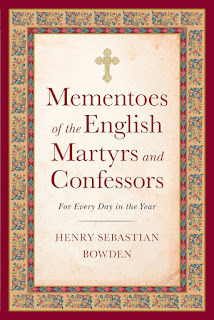 In our series on the Mementoes of the English Martyrs and Confessors based on Father Henry Sebastian Bowden's selections of their stories, we'll next look at the imprisonment of Blessed Thomas Palasor, who had been declared Venerable when the book was originally published, and his two lay companions, John Norton and John Talbot. While they were in prison, someone tried to poison them--with quite unintended consequences!
In our series on the Mementoes of the English Martyrs and Confessors based on Father Henry Sebastian Bowden's selections of their stories, we'll next look at the imprisonment of Blessed Thomas Palasor, who had been declared Venerable when the book was originally published, and his two lay companions, John Norton and John Talbot. While they were in prison, someone tried to poison them--with quite unintended consequences!So on Monday, August 7, I'll be on the Son Rise Morning Show at my usual time: about 6:50 a.m. Central/7:50 a.m. Eastern: please listen live here and/or listen to the podcast later here.
With the title "Poison Detected" and the verse from Mark's Gospel (16:18), "They shall take up serpents and, if they shall drink any deadly thing, it shall not hurt them", Father Bowden describes how Father Palasor, Mr. John Talbot, and Mr. John Norton, were captured together in Yorkshire in Norton's home and brought to prison in Durham.
Father Palasor was served some broth for dinner and its appearance was startling: "the bone of mutton in the dish ran blood in the form of crosses and of O's in the broth" so he did not taste it or consume it. The maid took it back to the woman who had prepared it, who added some spices and sent it with the maid to the two laymen, who noticed the same phenomenon and did not taste the broth.
The maid, Mary Day, went to Father Palasor and "confessed that the broth had been poisoned by the malice of her mistress, the jailer's wife, and on her knees begged his forgiveness, and asked him to make her one of his Faith."
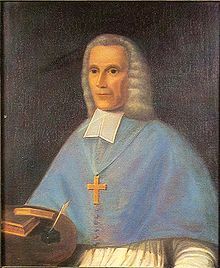 So Mary was received into the Catholic Church and left the jail to serve in the household of a Catholic lady, Eleanor Forcer, "who bore testimony to the occurrence", which is included in Bishop Richard Challoner's Memoirs of Missionary Priests and other Catholicks of both Sexes who suffered Death or Imprisonment in England on account of their Religion.
So Mary was received into the Catholic Church and left the jail to serve in the household of a Catholic lady, Eleanor Forcer, "who bore testimony to the occurrence", which is included in Bishop Richard Challoner's Memoirs of Missionary Priests and other Catholicks of both Sexes who suffered Death or Imprisonment in England on account of their Religion.As Bowden concludes this entry on the mementoes of Father Palasor and his companions: he was condemned to death for "returning to England as a priest, contrary to the statute" and they "received the same sentence for harboring and assisting him, and all three together were executed at Durham" on August 9, 1600. (p. 257)
The Catholic Encyclopedia provides some more detail about Blessed Thomas Palasor and his companions:
English martyr, born at Ellerton-upon-Swale, parish of Catterick, North Riding of Yorkshire; died at Durham 9 August, 1600. He arrived at Reims 24 July, 1592, whence he set out for Valladolid 24 August, 1592. There he was ordained priest in 1596. He was arrested in the house of John Norton, of Ravenswroth, nearly Lamesley, County Durham, who seems to have been the second son of Richard Norton, of Norton Conyers, attainted for his share in the Rebellion in 1569. Norton and his wife (if the above identification be correct, she was his second wife, Margaret, daughter of Christopher Redshaw of Owston) were arrested at the same time, and with them John Talbot, one of the Talbots of Thorton-le-Street, North Ridding of Yorkshire. All four were tried at Durham and condemned to death, Palasor for being a priest, and the others for assisting him. Another gentleman was condemned at the same time but saved his life by conforming, as they might have done. Mrs. Norton, being supposed to be with child, was reprieved. The others suffered together. Bishop Challoner tells how an attempt to poison Palasor and his companions made by the gaoler's wife resulted in the conversion of her maid-servant Mary Day.I mentioned that at the time Bowden composed this book, Palasor had been declared Venerable, but in 1987 Pope John Paul II beatified him. Misters Norton and Talbot were also beatified among those 85 Catholic Martyrs of England and Wales. As Pope John Paul II said in his homily at the Mass of Beatification:
And 25 years after their beatification, Vincent Cardinal Nichols celebrated a Mass at Westminster Cathedral on that anniversary and commented in his homily:
Among these eighty-five martyrs we find priests and laymen, scholars and craftsmen. The oldest was in his eighties, and the youngest no more than twenty-four. There were among them a printer, a bartender, a stable-hand, a tailor. What unites them all is the sacrifice of their lives in the service of Christ their Lord.
The priests among them wished only to feed their people with the Bread of Life and with the Word of the Gospel. To do so meant risking their lives. But for them this price was small compared to the riches they could bring to their people in the Holy Sacrifice of the Mass.
The twenty-two laymen in this group of martyrs shared to the full the same love of the Eucharist. They, too, repeatedly risked their lives, working together with their priests, assisting, protecting and sheltering them. Laymen and priests worked together; together they stood on the scaffold and together welcomed death. Many women, too, not included today in this group of martyrs, suffered for their faith and died in prison. They have earned our undying admiration and remembrance.
Of the eighty-five martyrs we remember and honour today, sixty-three were priests. They knew the risk they took in embarking on their priestly mission in these countries. They did so, above all, to bring the eternal riches of the Holy Mass to Catholics here. . . But it was the Mass that mattered. . . .
Twenty-two of these martyrs were laymen of different standings, professions and trades. They include married and family men. They were committed to the care and protection of their priests, for they too treasured the gift of the Mass above all other things. There are no women among this group of martyrs, for very few were ever put to death in that age. But many women, too, risked everything to play their part in the struggle for the faith.
Note that Mrs. Norton's supposed pregnancy prevented her from being executed by being hanged to death, which supports both the pope's and the cardinal's comments about how few women (the three canonized martyrs--Saints Margaret Clitherow, Margaret Ward, and Anne Line--being the exceptions) were martyred for the Faith in the Recusant/Penal era. But they endured great suffering, especially the loss, in Margaret Norton's case, of their husbands, and probably their homes and property, being seized by the state since their husbands were accounted traitors. Whether Margaret Norton died in prison or was released, I do not know.
Blessed Thomas Palasor, pray for us!Blessed John Norton, pray for us!Blessed John Talbot, pray for us!
July 27, 2023
Preview: "Those Boots are made for Martyrdom": Blessed Everard Hanse
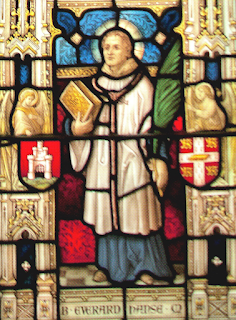 I know that's a pun that not even Scott Hahn should get away with, but in my defense, Father Henry Sebastian Bowden makes a pair of boots the center of his memento of Blessed Everard Hanse, who was hanged, drawn, and quartered on July 31, 1581 at Tyburn Tree. With the title, "Shod for the Gospel", and the verse, "How beautiful are the feet of them that preach the gospel of peace, of them that bring glad tidings of good things!" (Romans 10:15) Father Bowden emphasizes that Hanse's foreign made boots led to his imprisonment, trial, and martyrdom.
I know that's a pun that not even Scott Hahn should get away with, but in my defense, Father Henry Sebastian Bowden makes a pair of boots the center of his memento of Blessed Everard Hanse, who was hanged, drawn, and quartered on July 31, 1581 at Tyburn Tree. With the title, "Shod for the Gospel", and the verse, "How beautiful are the feet of them that preach the gospel of peace, of them that bring glad tidings of good things!" (Romans 10:15) Father Bowden emphasizes that Hanse's foreign made boots led to his imprisonment, trial, and martyrdom.So on Monday, July 31, we'll discuss the mementoes of Blessed Everard Hanse on the Son Rise Morning Show. I'll be on the air at my usual time: about 6:50 a.m. Central/7:50 a.m. Eastern: please listen live here and/or listen to the podcast later here!
Blessed Everard Hanse was born in an Anglican family in Northamptonshire, attended Cambridge University, and was ordained as a Church of England minister with a good living. His brother William had become a Catholic priest in Rheims and returned to England in 1579, hoping to bring Everard to the Catholic Church. As Father Bowden remarks, his brother's arguments weren't as persuasive as an illness Everard suffered: it "placed all things in a new light, and William had the consolation of receiving his brother into the Church." (p. 247)
Everard left England for Rheims, the seminary, and ordination and returned to England in 1581 as a missionary priest. Fatefully, only three months after returning to England, he visited some prisoners in the Marshalsea "when the jailer noticed the foreign make of his boots, and took him before a magistrate."
Father Hanse admitted that he was a Catholic priest and was imprisoned in Newgate.
In 1581, it was not yet treasonous for an Englishman just to be a Catholic priest in England, so the authorities had to find him guilty of a serious crime to sentence him to death. They did so at his trial, interpreting his statements that the pope had spiritual supremacy over him in England (denying Queen Elizabeth I's spiritual authority over him) and that he wished "all believed the Catholic Faith, as he did himself" (seen as his intention to persuade others to deny the Queen's supremacy and authority in religion) as proof of his treason. So he was sentenced to death and suffered at Tyburn on July 31, 1581.
Father Bowden adds the detail that when Blessed Everard Hanse's heart, cut out of his chest, was cast into the fire, "it leapt repeatedly, as if marking God's approval of his constancy." Bishop Challoner notes that the martyr's last words were "O happy day!"
He was beatified by Pope Leo XIII on December 29, 1886.
Blessed Everard Hanse, pray for us!
Image Credit (Stained glass from St Edmund's College Ware, used by permission).
July 20, 2023
Preview: A Welsh Martyr and His Companions in Prison
On Monday, July 24 on the Son Rise Morning Show we'll discuss the mementoes of Blessed William Davies, one of the Welsh martyrs beatified by Pope John Paul II in 1987. I'll be on the air at my usual time: about 6:50 a.m. Central/7:50 a.m. Eastern: please listen live here and/or listen to the podcast later here!
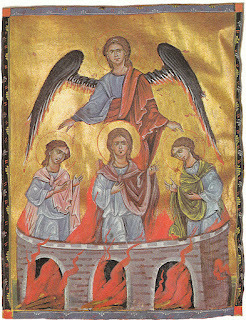 With the title "The Three Children in the Furnace" and the verse from the Book of Daniel describing Shadrach, Meshach, and Abegnego as "they walked in the midst of the flame, praising God and blessing the Lord" (3:34), Father Henry Sebastian Bowden describes the way that Father Davies and his flock in prison prepared for his martyrdom with prayer and praise.
With the title "The Three Children in the Furnace" and the verse from the Book of Daniel describing Shadrach, Meshach, and Abegnego as "they walked in the midst of the flame, praising God and blessing the Lord" (3:34), Father Henry Sebastian Bowden describes the way that Father Davies and his flock in prison prepared for his martyrdom with prayer and praise.They were imprisoned in Beaumaris Castle, in Beaumaris, Angelesey, Wales, for about six months before his execution on July 27, 1593. Father Bowden explains that Blessed Williams Davies and the young men arrested and imprisoned with him were allowed great freedom in prison. Although they'd been arrested because of their Catholic faith, they were allowed practice it! Here is the daily Rule they followed:
4:00 a.m.: Meditation5:00 a.m.: Mass, following by chanting O Sacrum Convivium/O Sacred Banquet:O sacred banquet!in which Christ is received,the memory of his Passion is renewed,the mind is filled with grace,and a pledge of future glory to us is given.Alleluia.Time for reading, study, prayer; with the Imitation of Christ read aloud after meals; Instructions from Father Davies; praying the Rosary, the Litany of the Blessed Virgin Mary and the Litany of the Saints everyday.Confession twice a week and receiving Holy Communion at Sunday and Holy Day Masses.Since the four young men were destined for seminary formation, he was preparing them, even though they'd been sentenced to life imprisonment.Blessed William Davies had been ordained at Reims in April of 1585 and had returned to Wales as a missionary priest. Nearly seven years later, in March 1592, he was arrested with those four students he was sending to the English College in Valladolid, Spain and confessed that he was a priest. Catholics visited him in prison and Protestant ministers came to dispute with him. Once he was taken to a church for a debate, but the ministers began to celebrate an Anglican service and Father Davies recited Vespers in Latin!
One of things he is most famous for before his arrest and imprisonment is his book Y Drych Christianogawl (The Christian Mirror), the first book printed in Wales. According to The National Library of Wales:
"Y Drych Cristianogawl" is a work of importance as an example of an early Welsh Catholic book and also for the fact that it is the first book to have been printed on Welsh soil. Welsh books of the pre-1586/87 years came off London presses, the one exception being Morys Clynnog's Milan volume. Four copies only are extant, three of which are imperfect. It has all the appearances of a book printed in Britain rather than in France. The story of its printing is a romantic one and one of bravery in the face of danger. . . .
When Blessed William Davies was found guilty of the crime of being a Catholic priest and sentenced to death, he chanted the Te Deum Laudamus! According to the Catholic Encyclopedia :
At the summer assizes it was decided that the priest must die as a traitor, though he was offered his life if he would go but once to church. In spite of the then open opposition of the people, who honoured him as a saint, the cruel sentence was carried out and he was hanged, drawn, and quartered at Beaumaris. As he put the rope round his neck, the martyr said: " Thy yoke, O Lord is sweet and Thy burden is light." His cassock stained with his blood was brought by his companions and preserved as a relic. They, though condemned to imprisonment for life, managed in time to escape, and the youngest found his way at last to Valladolid, where he recounted the whole story to Bishop Yepes, who wrote it in his "Historia particular de la Persecucion en Inglaterra".
Like the printing of his book, his life and death is a story of bravery in the face of danger and the romance of Faith!
Blessed William Davies, pray for us!
Image Source (Public Domain); Fiery furnace by Toros Roslin, Mashtots, 1266 (MS No. 2027, Fol. 14 V.) (Armenian art)
July 13, 2023
Preview: A Priest and Layman in Warwick
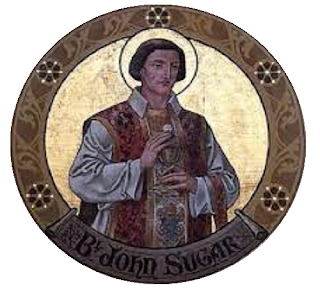 Our last two martyrs were among the first of the English Reformation era in our Son Rise Morning Show series (Saints John Fisher and Thomas More). With these two martyrs, Blesseds John Sugar and Robert Grissold (Venerables at the time of Father Henry Sebastian Bowden's work) we skip ahead to the beginning of the Stuart Dynasty in England. They suffered martyrdom on July 16, 1604, in Warwick.I'll be on the Son Rise Morning Show at my usual time on Monday, July 17: about 6:50 a.m. Central/7:50 a.m. Eastern: please listen live here and/or listen to the podcast later here!
Our last two martyrs were among the first of the English Reformation era in our Son Rise Morning Show series (Saints John Fisher and Thomas More). With these two martyrs, Blesseds John Sugar and Robert Grissold (Venerables at the time of Father Henry Sebastian Bowden's work) we skip ahead to the beginning of the Stuart Dynasty in England. They suffered martyrdom on July 16, 1604, in Warwick.I'll be on the Son Rise Morning Show at my usual time on Monday, July 17: about 6:50 a.m. Central/7:50 a.m. Eastern: please listen live here and/or listen to the podcast later here!With the title "The Continuity Theory" and the verse from Ephesians 2:19-20 ("You are fellow citizens with the saints . . . built upon the foundation of the apostles and prophets, Jesus Christ Himself being the chief cornerstone"), Father Bowden sketches out Father Sugar's career before he became a Catholic missionary priest: he was born and raised in a Staffordshire County family, attended Merton College at the University of Oxford and left without taking a degree because he would not swear the Oath of Supremacy during Queen Elizabeth I's reign. Nevertheless, he served as a Church of England minister in his native Midland county, preaching against the Catholic Church and the Papacy.
But something changed his mind and he left England to study for the Catholic priesthood at Douai, returning to the Midlands of England in 1601 as a missionary priest.
He and Blessed Robert Grissold, a layman, were arrested on July 8, 1603 in Warwick. Father Sugar was accused merely of being a Catholic priest present in England under the "Jesuits, etc. Act 1584", (27 Eliz. 1. c. 2) and he was found guilty after being held in prison for a year on July 14, 1604.
Father Bowden includes a couple of details from the day of Blessed John Sugar's martyrdom: he practiced some Catholic apologetics before being hanged, drawn, and quartered, asking the Church of England minister who had brought the Christian Faith to England. When the minister would not reply, he credited the successor of St. Peter, Pope Eleutherius, who sent missionaries Damianus and Fugatius to King Lucian, and said the religion practiced in England in their time "had crept in" during the reign of Henry VIII! Pope Saint Eleutherius reigned from around 174 to 189 A.D. and was one of the Greek Popes. The Venerable Bede mentions this story of an early mission to England.
Before he suffered--and he was conscious when he was disemboweled and beheaded--Blessed Father Sugar proclaimed "My true birth in this world began with the sign of the cross, and with that sign I leave it again."
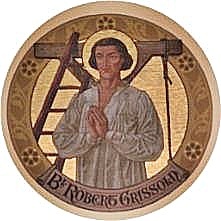 Blessed Robert Grissold, or Griswold, was arrested by his cousin Clement while accompanying Father Sugar and accused of aiding a priest. He was offered clemency throughout his imprisonment from July of 1603 until July of 1604, if he would just attend a Church of England service, but he refused. Saint Catherine of Alexandria was his patron saint.
Blessed Robert Grissold, or Griswold, was arrested by his cousin Clement while accompanying Father Sugar and accused of aiding a priest. He was offered clemency throughout his imprisonment from July of 1603 until July of 1604, if he would just attend a Church of England service, but he refused. Saint Catherine of Alexandria was his patron saint. On the day of their execution, Grissold was warned not to follow behind Father Sugar who was being dragged on a sledge through the mud. He replied "I have not thus far followed him to leave him for a little mire." Although he was usually afraid of seeing blood, he "gazed unmoved at the quartering of Ven. Sugar's body" and even dipped the noose of the rope with which he would be hanged in the priest's blood. He gave thanks that he was to die with him.
Father Bowden titled his entry "Zeal for Martyrdom" and cited Acts 21:13 as the verse to accompany his mementoes: "For I am ready not only to be bound, but to die also in Jerusalem, for the name of the Lord Jesus."
Their martyrdoms must have been a remarkable scene in Warwick on July 16, 1604: a priest and a layman witnessing to the Faith so bravely and boldly. They were beatified in 1987 by Pope St. John Paul II.
Blessed John Sugar, pray for us!Blessed Robert Grissold, pray for us!
Blessed John Sugar Image Source: shared under permission under a Creative Commons Attribution.Blessed Robert Grissold Image Source (Public Domain).
There is a painting of Grissold standing behind Sugar on the sledge in the mud on this website. The artist is Rebecca Dulcibella Orpen (1830?-1923) aka Rebecca Dering, one of The Quartet at Baddlesley Clinton in Warwickshire. Baddlesley Clinton had been known as recusant household in the 1590's and the nineteenth century Quartet (Rebecca, her husband Marmion Edward Ferrers, Lady Georgiana Chatterton and her husband Sir William) were converts to Catholicism.
Icons of Blesseds John Sugar and Robert Grissold are also included in the frieze behind the main altar in St. Francis of Assisi Catholic Church in Baddlesley Clinton.
July 6, 2023
Preview: Mementoes of Saint Thomas More
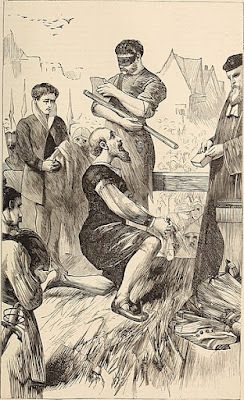 July 7 was the Feast of the Translation of St. Thomas Becket at the time of St. Thomas More's execution. In 1220 the relics of Becket were moved (translated) from his tomb in the Cathedral Crypt to a new elaborate shrine in the Trinity Chapel.
July 7 was the Feast of the Translation of St. Thomas Becket at the time of St. Thomas More's execution. In 1220 the relics of Becket were moved (translated) from his tomb in the Cathedral Crypt to a new elaborate shrine in the Trinity Chapel. Canterbury Cathedral still remembers this date with Solemn Evensong and a Procession, even though Henry VIII had Becket's shrine destroyed and his remains desecrated in 1538. Henry VIII went even further than that, of course, in his Proclamation of November 17, 1538:
Therefore his Grace strayghtly chargeth and commandeth that from henseforth the sayde Thomas Becket shall not be estemed, named, reputed, nor called a sayncte, but bysshop Becket; and that his ymages and pictures, through the hole realme, shall be putte downe, and avoyded out of all churches, chapelles, and other places; and that from henseforthe, the dayes used to be festivall in his name shall not be observed, nor the service, office, antiphoners, colletes, and prayers, in his name redde, but rased and put out of all the bokes.”
But in 1535, that hadn't yet been decreed and St. Thomas More cited this feast of Becket in his last letter to his daughter Margaret, as he thought it appropriate for his execution to occur the day before it:
I cumber you, good Margaret, much, but I would be sorry, if it should be any longer than tomorrow, for it is Saint Thomas' Even and the Utas [Octave] of Saint Peter and therefore tomorrow long I to go to God, it were a day very meet and convenient for me.
On Monday, July 10, we'll discuss the mementoes of St. Thomas More in Father Henry Sebastian Bowden's daily reflections on the English Martyrs and Confessors. I'll be on the Son Rise Morning Show at my usual time: about 6:50 a.m. Central/7:50 a.m. Eastern: please listen live here and/or listen to the podcast later here!Father Bowden did not surround the date of More's execution with as many memories as he did Bishop Fisher's; he highlights More's behavior on the scaffold on July 6, which might provide an answer to the question: did More say "but God's servant first" or "and God's servant first"?
The account Bowden is basically chronicler Edward Hall's version: More was so weak that he had to ask for help up the scaffold: 'See me safe up,' he said to Sir William Kingston, Constable of the Tower. 'For my coming down I can shift for myself.' He had been asked not to speak much so he asked those witnessing his execution for their prayers, and desired "them to bear witness for him that he died in the faith of the holy Catholic Church, and a faithful servant of God and the King."
Since there is no use of the word "but" and the Paris Newsletter , published on August 4 (less than a month later) the same year doesn't use the word "but" either, perhaps we should always the word "and":
He then besought them earnestly to pray to God to give the King good counsel, protesting that he died his faithful servant, and God's first.
He prayed the Miserere Psalm, thanked the executioner and then asked him to please aim true:
'Thou art to do me the greatest benefit that I can receive,' he said. 'Pluck up thy spirit, man, and be not afraid to do thine office. My neck is very short. Take heed therefore that thou strike not awry for saving of thine honesty.'
More stopped the executioner briefly to move his beard off the block, saying it had done no treason. "So with great alacrity and spiritual joy he received the fatal blow."
Edward Hall didn't know what to think about More's humor on the scaffold, with these jokes about his beard, his short neck, and his method of getting off the scaffold:
I cannot tell whether I should call him a foolish wiseman, or a wise foolishman, for undoubtedly he beside his learning, had a great wit, but it was so mingled with taunting and mocking, that it seemed to them that best knew him, that he thought nothing to be well spoken except he had ministered some mock in the communication . . .
Like Saint John Fisher, who demonstrated his faithful and resolute demeanor before his execution, I think More was just being himself, able to face death with good humor and even wit. He had prepared for his death by meditation on Our Lord's Passion and ready to face this more merciful execution (instead of being hanged, drawn, and quartered), but he still didn't want the headsman to miss!
Saint Thomas More, pray for us!
June 29, 2023
Preview: NO Preview: An Independence Day Break
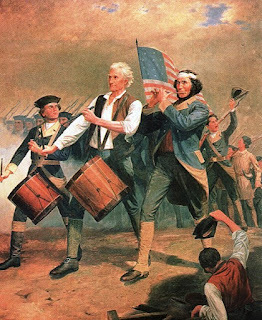 Just to let you know that I won't be on the Son Rise Morning Show on Monday, July 3rd! The hosts and producers of the program are taking the day off--and the Fourth of July, Independence Day too, and the rest of the week too--during a summer break!
Just to let you know that I won't be on the Son Rise Morning Show on Monday, July 3rd! The hosts and producers of the program are taking the day off--and the Fourth of July, Independence Day too, and the rest of the week too--during a summer break!We will be back to continue our series on Father Henry Sebastian Bowden's Mementoes of the English Martyrs and Confessors on Monday, July 10, with a segment on Saint Thomas More!
Also, today, June 30, is the 55th anniversary of Pope Saint Paul VI's issuance of his Moto Proprio on The Creed of the People of God:
According to this earlier issue of The Pilot from Boston:
In his apostolic letter (“Solemni Hac Liturgia”) accompanying the Credo, Pope Paul VI noted that the text “repeats in substance, with some developments called for by the spiritual condition of our time, the creed of Nicea, the creed of the immortal tradition of the holy Church of God.”
According to the pope, the Credo was issued due to concerns about “the disquiet which agitates certain modern quarters with regard to the faith,” “the influence of a world being profoundly changed, in which so many certainties are being disputed or discussed,” “even Catholics allowing themselves to be seized by a kind of passion for change and novelty,” and “disturbance and perplexity in many faithful souls.”
Jacques Maritain drafted the Credo at the Pope's request.
Image Credit (Public Domain): Originally entitled Yankee Doodle, this is one of several versions of a scene painted by A. M. Willard that came to be known as The Spirit of '76. Often imitated or parodied, it is a familiar symbol of American patriotism
June 26, 2023
Three Books of Hours and a Roman Missal in the News
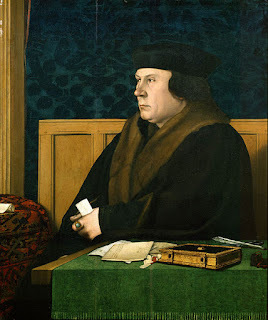 More recently there was the news that Thomas Cromwell owned a copy of the same Book of Hours that's included in Holbein's portrait, as the Smithsonian Magazine reported:
More recently there was the news that Thomas Cromwell owned a copy of the same Book of Hours that's included in Holbein's portrait, as the Smithsonian Magazine reported:Through her research, McCaffrey [Kate McCaffrey, who identified and researched the provenance of the two queens' books] learned of the existence of a third copy of the Book of Hours—one donated to Cambridge by Dame Anne Sadleir in August 1660. When Hever’s curatorial team viewed the copy, Palmer pointed out its resemblance to the volume lying on a green tablecloth in the famous portrait, which Holbein painted between 1532 and 1533.
Palmer, Emmerson and McCaffrey began searching for more evidence to confirm the connection. They looked into the Cambridge book’s provenance, tracing its ownership from Cromwell to Sadleir, whose husband was the grandson of Cromwell’s secretary Ralph Sadleir (also spelled Sadler). The trio then shared their research with leading experts like Borman, who examined their findings and came to the same conclusion.
Previously, researchers had paid little attention to the Cambridge copy, which was known as the Hardouyn Hours after its printer. As Emmerson tells Artnet’s Richard Whiddington, scholars studying this era tend to focus more on handwritten texts than printed books. Additionally, the book “has remained uncleaned for many decades, with dirt and tarnish masking the finer details of the silver-gilt binding.”
I wonder about the attempts to use the fact that two of Henry VIII's queens and Thomas Cromwell used the same edition of a prayer book as an insight into their relationships, as the same article from the Smithsonian website quotes two of the specialists involved:
“This book of devotional prayers is remarkable for its unusually grand binding, covered with velvet, jewels and highly decorated silver gilt borders, all of which date from the time it was printed and illuminated,” says Nicolas Bell, a librarian at Cambridge’s Trinity College, in the statement. “It has been enormously exciting to position this luxurious creation in the very center of the court of Henry VIII, where we know that both Catherine of Aragon and Anne Boleyn owned copies of the very same edition.” . . .
The newly identified prayer book “gives us a little window into” the everyday lives of three giants of Tudor history, Emmerson tells the Times. “We often see them as adversaries, but they were also in each other’s company. They had to get along for propriety’s sake. It’s a surprising connection between these otherwise warring individuals.”
I don't think it's that surprising at all: the Book of Hours was the prayer book used at the time by pious laity. Why would the three of them praying with the same book mean they were getting "along for propriety's sake"? Do the curators imagine them meeting in a chapel and praying an hour antiphonally? How common was ownership of this particular printed edition? Has that been considered while highlighting these connections? As the MET in New York City notes:
A century later, the invention and adoption of printing made books of hours even more accessible to a wider audience, and a press like that of the Hardouyn family (89.27.4, fols. 5v–6r) made copies by the dozen or more. However numerous and easy to produce, the widespread printed books of hours never attained the appeal of the finest handmade manuscript copies, each one not only a functional prayer book but a unique work of art.
More on mass-produced Books of Hours here.
Besides, as the Smithsonian story comments, the inclusion of Cromwell's Book of Hours may have a different, non-religious or devotional purpose: "The book’s inclusion in the Holbein portrait may allude to Cromwell’s recent appointment as Master of the Jewels [in April 1532]". And as the Tower of London website notes:
It was almost certainly to celebrate his appointment as Master of the Jewels that Cromwell commissioned Hans Holbein, the most celebrated artist of the age, to paint his portrait in around 1532-33.It wasn't to show Cromwell's sentimental attachment to that Book of Hours, as Owen Emmerson avers: it was to announce that he was moving up at Court--he's not looking that jeweled book, he's displaying it!
 Now comes the news that Father John Huddleston's Roman Missal has been identified and obtained for Moseley Old Hall in Staffordshire, stressing its connection to the relationship between the Benedictine priest who sheltered the then King of Scotland after defeat at the Battle of Worcester and King Charles II's deathbed conversion in 1685:
Now comes the news that Father John Huddleston's Roman Missal has been identified and obtained for Moseley Old Hall in Staffordshire, stressing its connection to the relationship between the Benedictine priest who sheltered the then King of Scotland after defeat at the Battle of Worcester and King Charles II's deathbed conversion in 1685:Father John Huddleston was a Benedictine priest who resided at Moseley Old Hall during the time that Charles II sought refuge here in 1651.
When Charles arrived at Moseley on 8th September 1651, Father Huddleston gave him shelter in his own first-floor bedroom and it is believed that during his time here, Charles consulted a collection of Father Huddleston's books, with the missal likely to have been one of them.
When Charles II returned to England as king in 1660, he made Father Huddleston chaplain to his mother, Queen Henrietta Maria, and then later to his wife, Catherine of Braganza. Father Huddleston was held in high regard by the king, so much so that in 1685, as King Charles II lay dying in Whitehall Palace in London, Father Huddleston was summoned to his bedside to hear the king’s confession, administer the Eucharist and receive him into the Catholic Church.
Whether or not King Charles II of Scotland was likely to have read or prayed with Father Huddleston's Roman Missal in 1651 seems uncertain to me. If Father Huddleston was using the Roman Missal for daily Mass, etc., it might not have been available to Charles to consult, unless he was attending the Masses. Father Huddleston might indeed have had this Roman Missal with him when he received Charles into the Church, but that detail/provenance is not mentioned.
As for Father Huddleston after that famous deathbed conversion, the old Catholic Encyclopedia has these details:
On the accession of James II, Huddleston continued to reside with the Queen Dowager at Somerset House. Shortly before his death his mind failed and he was placed in the charge of "the Popish Lord Feversham", one of the few persons present at Charles II's reconciliation to the Church, who managed his affairs as trustee. To this arrangement is probably due the unusual circumstance that the probate of his will was obtained the day before his funeral. He was buried in the churchyard of St. Mary le Strand (Parish Register, MS.).
Image Credit (public domain) Holbein's portrait of Thomas Cromwell
Image Credit (public domain): Portrait of Dom John Huddleston O.S.B. (1608-98), after a portrait by Jacob Huysmans
June 22, 2023
Preview: Saint John Fisher on the Son Rise Morning Show
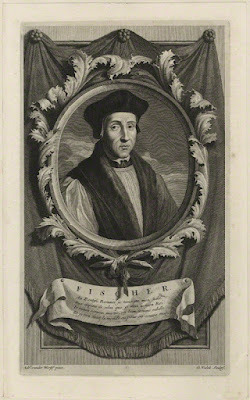 As might be expected, Father Henry Sebastian Bowden dedicates more than one day to the memory of Saint John Fisher, Cardinal Bishop of England in his book Mementoes of the English Martyrs and Confessors. Around the date of his June 22, 1535 beheading Father Bowden includes five:
As might be expected, Father Henry Sebastian Bowden dedicates more than one day to the memory of Saint John Fisher, Cardinal Bishop of England in his book Mementoes of the English Martyrs and Confessors. Around the date of his June 22, 1535 beheading Father Bowden includes five:June 22: Ascending the StepsJune 23: Learning for LifeJune 24: The Wedding GarmentJune 25: A Martyr's Sleep, andJune 26: The Bones of Elias
On Monday, June 26 on the Son Rise Morning Show, we'll reflect on the memory of Saint John Fisher stopping on the way from the Tower to Tower Hill to open his New Testament and pray for a suitable verse to sustain him before his execution. I'll be on the Son Rise Morning Show at my usual time: about 6:50 a.m. Central/7:50 a.m. Eastern: please listen live here and/or listen to the podcast later here!
We should remember that Bishop John Fisher was a brilliant scholarly and a holy man, renowned for both among his peers in England and on the Continent. As the old Dictionary of National Biography explains:
In 1501 he was elected vice-chancellor of [Cambridge] university. We learn from his own statements, as well as from other sources, that the whole academic community was at that time in a singularly lifeless and impoverished state. To rescue it from this condition, by infusing new life into its studies and gaining for it the help of the wealthy, was one of the chief services which Fisher rendered to his age. In 1503 he was appointed by the Countess of Richmond [Margaret Beaufort, Henry VII's mother and Henry VIII's grandmother] to fill the newly founded chair of divinity, which she had instituted for the purpose of providing gratuitous theological instruction in the university; and it appears to have been mainly by his advice that about the same time the countess also founded the Lady Margaret preachership, designed for supplying evangelical instruction of the laity in the surrounding county and elsewhere. The preaching was to be in the vernacular, which had at that period almost fallen into disuse in the pulpit. . . .
Fisher's genuine attachment to learning is shown by the sympathy which he evinced with the new spirit of biblical criticism which had accompanied the Renaissance. It was mainly through his influence that Erasmus was induced to visit Cambridge, and the latter expressly attributes it to his powerful protection that the study of Greek was allowed to go on in the university without active molestation of the kind which it had to encounter at Oxford (Epist. vi. 2). Notwithstanding his advanced years, Fisher himself aspired to become a Greek scholar, and appears to have made some attainments in the language.
Yet as he goes to his death, so weak that he has to carried in a chair, he stops, stands up, leans against a wall and opens his small New Testament book at random, praying:
"O Lord, this is the last time that ever I shall open this book. Let some comfortable place now chance unto me--" and he opens it to John 17:3-4:
"This is everlasting life, that they may know Thee, the only true God, and Jesus Christ Whom Thou hast sent. I have glorified Thee on earth, I have finished the work that Thou gavest me to do."
Having read that he said, "Here is even learning enough for me to my life's end."
Father Bowden chose Psalm 138:6 for this daily entry: "Thy knowledge is become wonderful to me."
His calmness and readiness for his martyrdom is also demonstrated in his final preparations for his execution: Awakened early the morning of June 22, 1535, he asked to be allowed to sleep a few more hours until 9:00 a.m., the time set for him to die ("A Martyr's Sleep"), and he dressed warmly before he left his cell ("The Wedding Garment"). He was asked not to make any speech on the scaffold and he was content with that.
On the scaffold ("Ascending the Steps"), Father Bowden provides the detail that Saint John Fisher recited another Psalm (33:6): "Come ye to Him and be enlightened, and your faces shall be confounded." He forgave the executioner and removed his gown and tippet (like a stole over his shoulders) and the crowd there to witness his execution was shocked at how emaciated he was because his face was "a mere death's head". His body was left on the scaffold but his head was prepared for exhibition on London Bridge, where it stopped the traffic because his face seemed to look more lifelike! ("The Bones of Elias") Finally his head was dumped into the Thames and replaced by St. Thomas More's.
Speaking of St. Thomas More's head, which was retrieved by his daughter Margaret Roper before it could be dumped into the Thames, there are fears that his skull, a major relic, is deteriorating in the vaults of St. Dunstan's Anglican church in Canterbury. It is buried in the church because the Roper family vault is there and Margaret's husband Will Roper, kept the relic after her death.
Saint John Fisher, pray for us!



